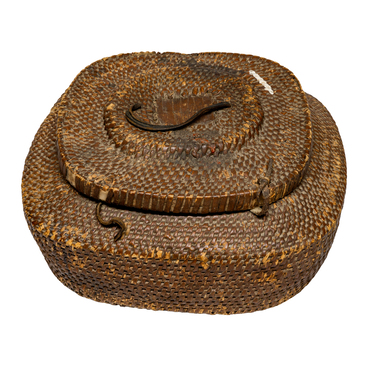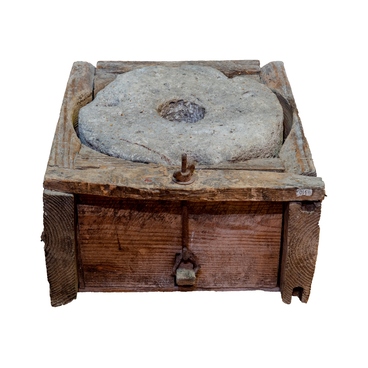The term “trumeau” came from the French language and was used to denote a pier. Such names were given to the mirrors, which were installed or hung on the wall between the window and the door.
The mirror from the collection of Nizhnevartovsk Museum of Local History consists of three parts. The bottom part, the so-called mirror table, is made of a smooth wooden board and decorated with a carved frame around the perimeter. A relief decorative strip is in its center. The mirror itself is above the mirror table in a wide frame with semicircular chiseled details on its sides. One more mirror of a smaller size is built in the upper part. The frame of a smaller mirror is covered with a geometric pattern made in the incised carving technique. This type of decoration was one of the most ancient. Craftsmen used just a knife to make such decorations.
On the reverse side of a trumeau mirror, you can see bars with some attached details. The large part of a mirror is fixed with thin planks and nails on its backside, the small part is located in a special cut. The inside of the mirror is covered with canvas, which is impregnated with fish glue. This substance protected a mirror from dust and moisture.
There is a forged loop with a movable metal ring in the upper part of a trumeau. It was used to hang a mirror on a wall.
This trumeau mirror belonged to the Kushnikovs, who were merchants from an old Surgut family. It was a part of Taisya Kaydalova’s dowry. The mirror was bought at the Irbit Fair, which was one of the largest in the Russian Empire.
It is widely believed that Venetian glassmakers invented the mirrors. They were the first who learned to cut a hot glass ball in half and then roll each part into a flat sheet. The bottom side of a future mirror was covered with foil and amalgam. This process was difficult, long, and hazardous at the same time. Mirrors were very expensive and considered to be luxurious items. The secrets of mirror making were kept private. The craftsmen were forbidden to leave Venice under the penalty of death.
A simpler and safer way of making mirrors was invented in France in the 19th century. Mercury was replaced with silver, and the glass was not rolled out anymore, but cast in a necessary shape.
The mirror from the collection of Nizhnevartovsk Museum of Local History consists of three parts. The bottom part, the so-called mirror table, is made of a smooth wooden board and decorated with a carved frame around the perimeter. A relief decorative strip is in its center. The mirror itself is above the mirror table in a wide frame with semicircular chiseled details on its sides. One more mirror of a smaller size is built in the upper part. The frame of a smaller mirror is covered with a geometric pattern made in the incised carving technique. This type of decoration was one of the most ancient. Craftsmen used just a knife to make such decorations.
On the reverse side of a trumeau mirror, you can see bars with some attached details. The large part of a mirror is fixed with thin planks and nails on its backside, the small part is located in a special cut. The inside of the mirror is covered with canvas, which is impregnated with fish glue. This substance protected a mirror from dust and moisture.
There is a forged loop with a movable metal ring in the upper part of a trumeau. It was used to hang a mirror on a wall.
This trumeau mirror belonged to the Kushnikovs, who were merchants from an old Surgut family. It was a part of Taisya Kaydalova’s dowry. The mirror was bought at the Irbit Fair, which was one of the largest in the Russian Empire.
It is widely believed that Venetian glassmakers invented the mirrors. They were the first who learned to cut a hot glass ball in half and then roll each part into a flat sheet. The bottom side of a future mirror was covered with foil and amalgam. This process was difficult, long, and hazardous at the same time. Mirrors were very expensive and considered to be luxurious items. The secrets of mirror making were kept private. The craftsmen were forbidden to leave Venice under the penalty of death.
A simpler and safer way of making mirrors was invented in France in the 19th century. Mercury was replaced with silver, and the glass was not rolled out anymore, but cast in a necessary shape.



